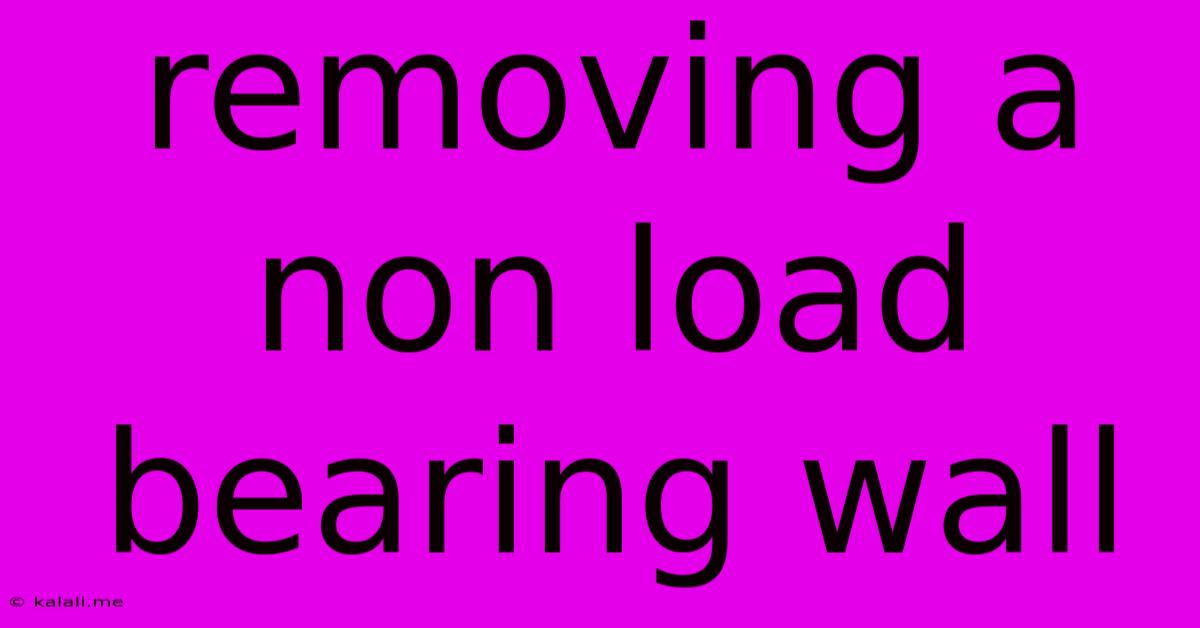Removing A Non Load Bearing Wall
Kalali
May 21, 2025 · 4 min read

Table of Contents
Removing a Non-Load Bearing Wall: A Comprehensive Guide
Meta Description: Learn how to safely remove a non-load bearing wall, including identifying the wall type, necessary tools, permits, and step-by-step instructions. Transform your home with this DIY project, but prioritize safety!
Removing a non-load bearing wall can dramatically open up your living space, creating a more spacious and modern feel. However, this seemingly simple DIY project requires careful planning and execution to ensure safety and structural integrity. This guide will walk you through the process, covering everything from identification to the final touches. Remember, if you're unsure about any step, always consult a qualified contractor.
1. Identifying a Non-Load Bearing Wall
The first and most crucial step is confirming that the wall is indeed non-load bearing. This means it doesn't support the weight of the roof or upper floors. Several indicators can help you determine this:
- Wall Location: Walls in the interior of your home are more likely to be non-load bearing than exterior walls or those directly beneath a beam.
- Wall Thickness: Non-load bearing walls are typically thinner than load-bearing walls. Measure the thickness – a wall less than 4 inches thick is a strong candidate for a non-load bearing wall.
- Construction Materials: Examine the wall's framing. Non-load bearing walls often use lighter materials, such as 2x4 studs, compared to load-bearing walls which typically use thicker 2x6 studs or even engineered lumber.
- Absence of Support Beams: Look for visible support beams or headers above the wall. The presence of these signifies that it's likely a load-bearing wall.
Caution: If you are unsure, it's crucial to consult a structural engineer or qualified contractor. Removing a load-bearing wall without proper support can lead to serious structural damage and safety hazards.
2. Necessary Tools and Materials
Before starting the demolition, gather the necessary tools and materials:
- Safety Gear: Safety glasses, dust mask, work gloves, and hearing protection are essential for protecting yourself from dust, debris, and potential injuries.
- Demolition Tools: A sledgehammer, crowbar, reciprocating saw (Sawzall), and pry bar will be helpful for dismantling the wall.
- Measuring Tools: Tape measure, level, and stud finder are crucial for accurate measurements and locating studs.
- Cleanup Tools: Shop vacuum, dustpan, broom, and trash bags are necessary for cleaning up after demolition.
- Repair Materials: Drywall, screws, mud, tape, and paint for patching and finishing the newly opened space.
3. Obtaining Necessary Permits
Check with your local building department to determine if you need a permit for removing a non-load bearing wall. Regulations vary by location. Obtaining the necessary permits ensures you are working within legal guidelines and prevents potential penalties.
4. Step-by-Step Demolition Process
Once you've confirmed the wall type, gathered your tools, and secured necessary permits, you can begin the demolition process. Remember to always prioritize safety:
- Turn off utilities: Turn off the power to any electrical outlets or switches in the wall.
- Locate and protect plumbing and electrical wiring: Carefully locate and mark the position of any plumbing pipes, electrical wiring, or other utilities within the wall. Protect these components to avoid damage.
- Remove the drywall: Carefully cut the drywall along the studs using a utility knife or reciprocating saw. Remove sections of drywall, exposing the framing.
- Remove the studs: Carefully remove the studs using a reciprocating saw, crowbar, or sledgehammer. Dispose of debris responsibly.
- Clean up: Thoroughly clean the area to remove debris and prepare for patching and finishing.
5. Patching and Finishing
After demolition, you'll need to patch and finish the area. This typically involves:
- Installing new framing (if necessary): Depending on the size of the opening and the condition of the existing framing, you may need to install new framing to ensure stability and support for the new opening.
- Installing drywall: Cut and install drywall to cover the opening.
- Taping and mudding: Tape the seams of the drywall and apply joint compound (mud) to create a smooth surface.
- Sanding and painting: Sand the mudded areas smooth, and then prime and paint the patched area to match the existing walls.
Removing a non-load bearing wall can greatly enhance your home's aesthetic and functionality. However, careful planning, accurate identification, and adherence to safety guidelines are paramount. If you're not confident in tackling this project yourself, always consult a professional. The cost of professional help is far less than the cost of fixing a serious structural mistake.
Latest Posts
Latest Posts
-
How Many Rakats In Jummah Prayer
May 21, 2025
-
Best Thing To Put In A Mouse Trap
May 21, 2025
-
Can You Mix Red Wine And White Wine
May 21, 2025
-
Can I Take Protein Powder On A Plane
May 21, 2025
-
How Far Is Euston Station From St Pancras
May 21, 2025
Related Post
Thank you for visiting our website which covers about Removing A Non Load Bearing Wall . We hope the information provided has been useful to you. Feel free to contact us if you have any questions or need further assistance. See you next time and don't miss to bookmark.